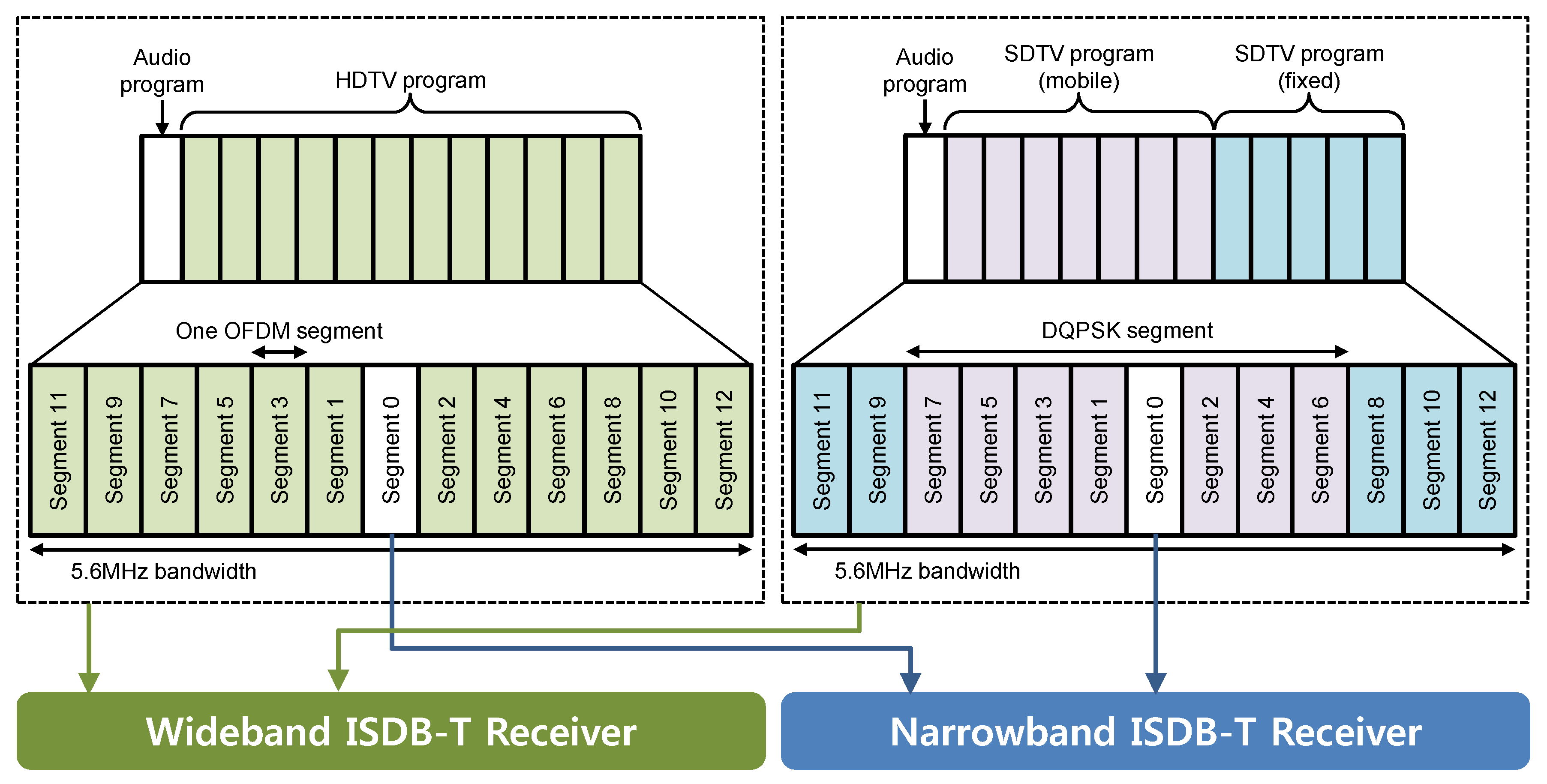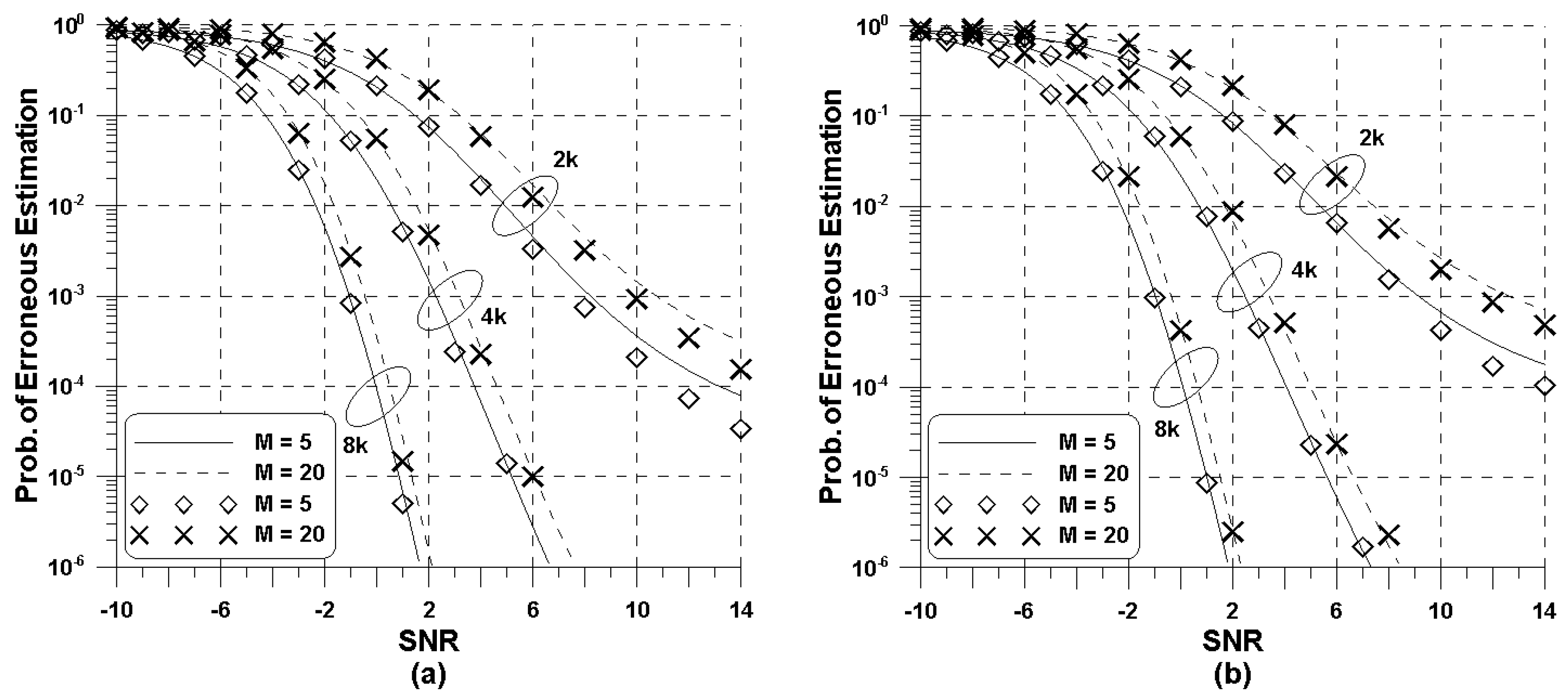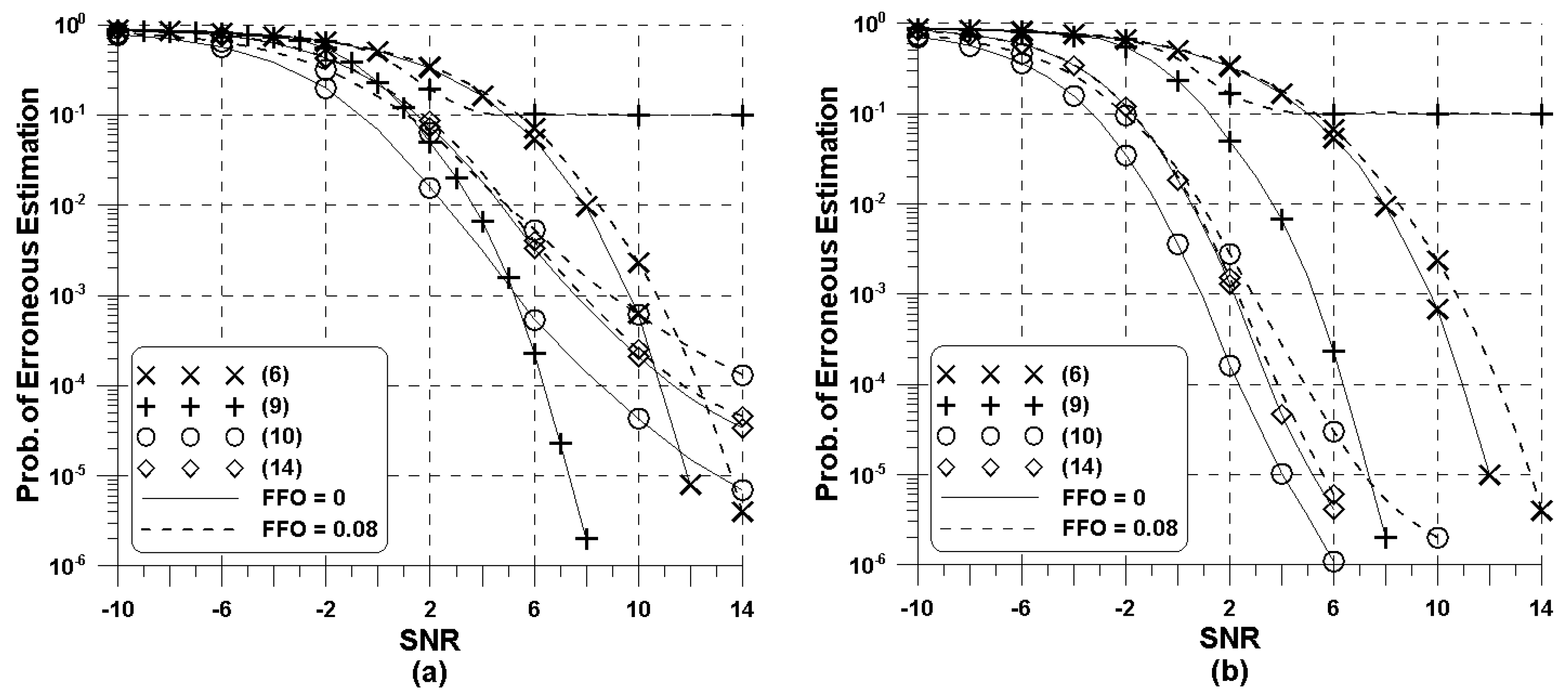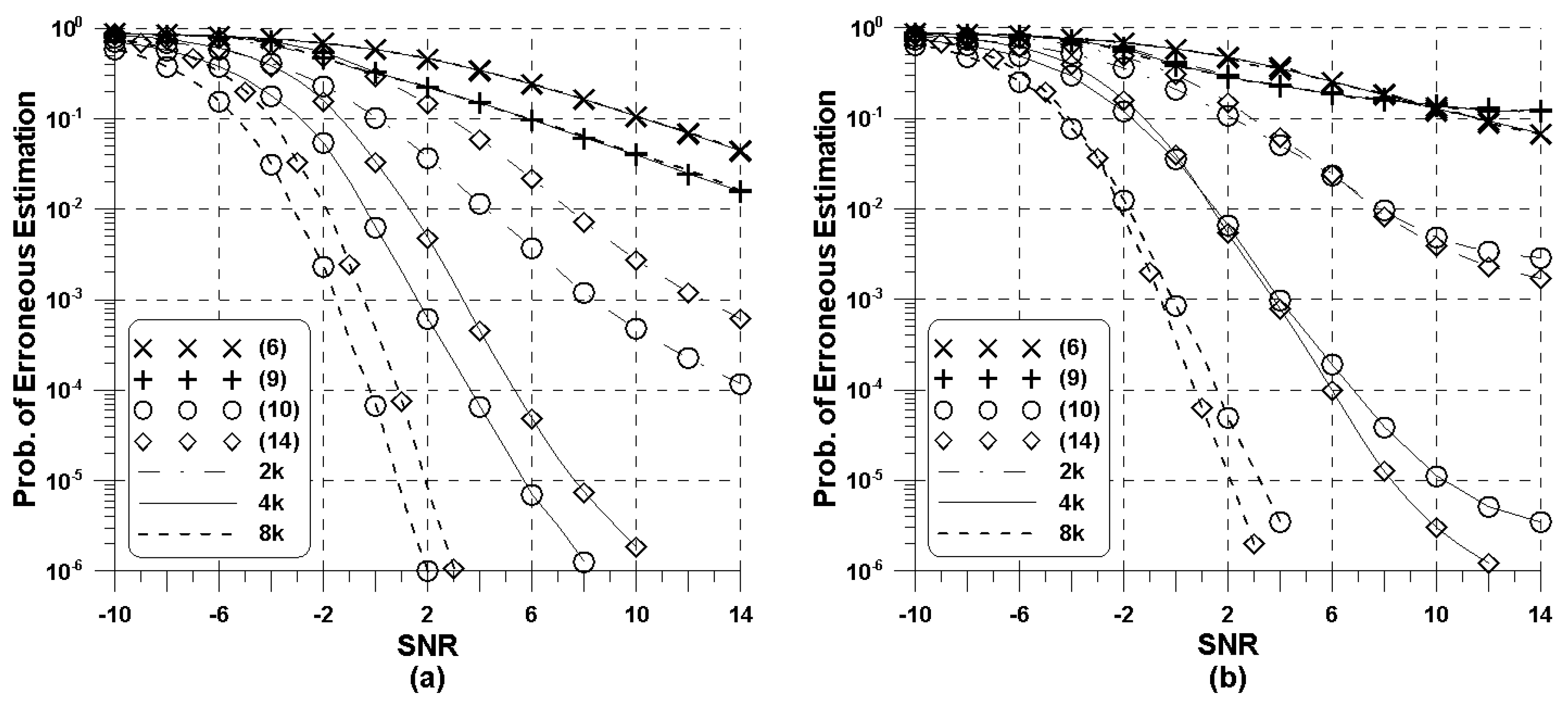Robust Blind Detection of Integer Carrier Frequency Offset for Terrestrial Broadcasting Systems Using Band Segmented Transmission
Abstract
:1. Introduction
1.1. Synchronization in OFDM
1.2. Contribution
2. System Description
3. Conventional Detection Schemes
3.1. Conventional Scheme A
3.2. Conventional Scheme B
3.3. Conventional Scheme C
4. Proposed Detection Scheme
4.1. Algorithm Description
4.2. Probability of Erroneous Estimation
5. Simulation Results
5.1. Performance Evaluation
5.2. Complexity Comparison
6. Conclusions
Author Contributions
Funding
Conflicts of Interest
References
- Document A/322. ATSC Standard: Physical Layer Protocol. Available online: https://www.atsc.org/ (accessed on 16 July 2018).
- GB20600-2006. Framing Structure, Channel Coding and Modulation for Digital Television Terrestrial Broadcasting System. Available online: https://www.gbstandards.org/ (accessed on 16 July 2018).
- ETSI EN 302 755 V.1.4.1. Digital video broadcasting (DVB). Frame Structure Channel Coding and Modulation for a Second Generation Digital Terrestrial Television Broadcasting System (DVB-T2); Association à but Non Lucratif: Grasse, France, 2015. [Google Scholar]
- ARIB Standard STD-B31 Ver.2.2. Transmission System for Digital Terrestrial Television Broadcasting. Available online: https://www.arib.or.jp/ (accessed on 16 July 2018).
- El-Hajjar, M.; Hanzo, L. A survey of digital television broadcast transmission techniques. IEEE Commun. Surv. Tutor. 2013, 15, 1924–1941. [Google Scholar] [CrossRef]
- Sotelo, R.; Joskowicz, J.; Rondan, N. An integrated broadcast-broadband system that merges ISDB-T with HbbTV 2.0. IEEE Trans. Broadcast. 2018, 64, 709–720. [Google Scholar] [CrossRef]
- Yuan, J.; Torlak, M. Joint CFO and SFO estimator for OFDM receiver using common reference frequency. IEEE Trans. Broadcast. 2016, 62, 141–149. [Google Scholar] [CrossRef]
- Ai, B.; Ge, J.-H.; Wang, Y.; Yang, S.-Y.; Liu, P. Decimal frequency offset estimation in COFDM wireless communications. IEEE Trans. Broadcast. 2004, 50, 154–158. [Google Scholar] [CrossRef]
- Cvetkovic, Z.; Tarokh, V.; Yoon, S. On frequency offset estimation for OFDM. IEEE Trans. Wirel. Commun. 2013, 12, 1062–1072. [Google Scholar] [CrossRef]
- Lmai, S.; Bourre, A.; Laot, C.; Houcke, S. An efficient blind estimation of carrier frequency offset in OFDM systems. IEEE Trans. Veh. Technol. 2014, 63, 1945–1950. [Google Scholar] [CrossRef]
- Zhou, M.; Feng, Z.; Liu, Y.; Huang, X. An efficient algorithm and hardware architecture for maximum-likelihood based carrier frequency offset estimation in MIMO systems. IEEE Access 2018, 6, 50105–50116. [Google Scholar] [CrossRef]
- Huang, D.; Letaief, K.B. Carrier frequency offset estimation for OFDM systems using null sub-carriers. IEEE Trans. Commun. 2006, 54, 813–823. [Google Scholar] [CrossRef]
- Zhu, J.; Lee, W. Carrier frequency offset estimation for OFDM systems with null subcarriers. IEEE Trans. Veh. Technol. 2006, 55, 1677–1690. [Google Scholar] [CrossRef]
- Zhan, Q.; Minn, H. New integer normalized carrier frequency offset estimators. IEEE Trans. Signal Process. 2015, 63, 3697–3710. [Google Scholar] [CrossRef]
- Toumpakaris, D.; Lee, J.W.; Lou, H.-L. Estimation of integer carrier frequency offset in OFDM systems based on the maximum likelihood principle. IEEE Trans. Broadcast. 2009, 55, 95–108. [Google Scholar] [CrossRef]
- Pham, T.H.; Fahmy, S.A.; McLoughlin, I.V. Efficient integer frequency offset estimation architecture for enhanced OFDM synchronization. IEEE Trans. Very Large Scale Integr. (VLSI) Syst. 2016, 24, 1412–1420. [Google Scholar] [CrossRef]
- Li, D.; Li, Y.; Zhang, H.; Cimini, L.; Fang, Y. Integer frequency offset estimation for OFDM systems with residual timing offset over frequency selective fading channels. IEEE Trans. Veh. Technol. 2012, 61, 2848–2853. [Google Scholar] [CrossRef]
- Marey, M. Integer CFO estimation algorithm for SFBC-OFDM systems. IEEE Commun. Lett. 2018, 22, 1632–1635. [Google Scholar] [CrossRef]
- Murin, Y.; Dabora, R. Low complexity estimation of carrier and sampling frequency offsets in burst-mode OFDM systems. Wirel. Commun. Mob. Comput. 2016, 16, 1018–1034. [Google Scholar] [CrossRef]
- Dantas, C.; Castro, D.; Panazio, C. On enhancing the pilot-aided sampling clock offset estimation of mobile OFDM systems. J. Commun. Inf. Syst. 2016, 31, 108–117. [Google Scholar] [CrossRef]
- Jung, Y.A.; You, Y.H. Effective blind frequency offset estimation scheme for BST-OFDM based HDTV broadcast systems. Symmetry 2018, 10, 379. [Google Scholar] [CrossRef]
- Paderna, R.; Thang, D.Q.; Hou, Y.; Higashino, T.; Okada, M. Low-complexity compressed sensing-based channel estimation with virtual oversampling for digital terrestrial television broadcasting. IEEE Trans. Broadcast. 2017, 63, 82–91. [Google Scholar] [CrossRef]
- Ferdian, R.; Hou, Y.; Okada, M. A low-complexity hardware implementation of compressed sensing-based channel estimation for ISDB-T system. IEEE Trans. Broadcast. 2017, 63, 92–102. [Google Scholar] [CrossRef]
- Gradshteyn, I.S.; Ryzhik, I.M. Table of Integrals, Series, and Products; Academic Press: Cambridge, MA, USA, 2014. [Google Scholar]
- Failli, M. Digital Land Mobile Radio Communications-COST 207; Final Report; Commission of the European Community: Brussels, Belgium, 1989. [Google Scholar]
- Golub, G.H.; Vanloan, C.F. Matrix Computations; The Johns Hopkins University Press: Baltimore, MA, USA, 1996. [Google Scholar]





| Parameters | 2k Mode | 4k Mode | 8k Mode |
|---|---|---|---|
| Bandwidth | 5.575 MHz | 5.573 MHz | 5.572 MHz |
| # of carriers per segments | 108 | 216 | 432 |
| # of used carriers | 1405 | 2809 | 5617 |
| # of GI samples | 256 | 512 | 1024 |
| # of common TMCC carriers | 13 | 26 | 52 |
© 2019 by the authors. Licensee MDPI, Basel, Switzerland. This article is an open access article distributed under the terms and conditions of the Creative Commons Attribution (CC BY) license (http://creativecommons.org/licenses/by/4.0/).
Share and Cite
Jung, Y.-A.; You, Y.-H. Robust Blind Detection of Integer Carrier Frequency Offset for Terrestrial Broadcasting Systems Using Band Segmented Transmission. Symmetry 2019, 11, 896. https://doi.org/10.3390/sym11070896
Jung Y-A, You Y-H. Robust Blind Detection of Integer Carrier Frequency Offset for Terrestrial Broadcasting Systems Using Band Segmented Transmission. Symmetry. 2019; 11(7):896. https://doi.org/10.3390/sym11070896
Chicago/Turabian StyleJung, Yong-An, and Young-Hwan You. 2019. "Robust Blind Detection of Integer Carrier Frequency Offset for Terrestrial Broadcasting Systems Using Band Segmented Transmission" Symmetry 11, no. 7: 896. https://doi.org/10.3390/sym11070896




